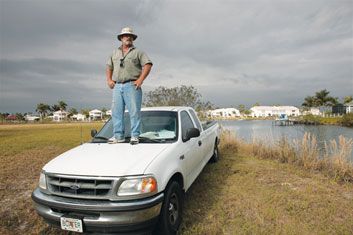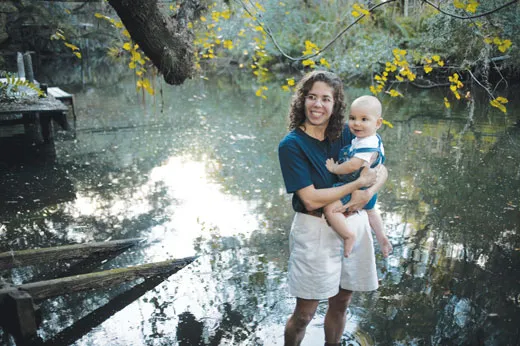Fury Over a Gentle Giant
Floridians raise a ruckus over manatees as biologists weigh prospects for the endangered species’ survival
As a chill wind rippled across the CaloosahatcheeRiver and into downtown Fort Myers, Florida, in December 2002, some 3,000 people surged through the doors of the riverfront convention center. Many waved signs. “Don’t Tread On Me!’’ “Don’t Give Up the Ship!’’ “Save Our Jobs!’’ One man, dressed in red, white and blue, bore a large white cross labeled “Property Rights.’’ There were skinny teenagers and white-haired retirees, scruffy sailors in tattered jeans, businessmen in sharply creased khakis, a woman in black leather pants and stiletto heels. What most of them had in common was anger at a proposed federal restriction on waterfront development that they felt would undermine their livelihoods and lifestyles for the sake of the manatee, a chubby, shy marine mammal known to old-timers as a sea cow. As one protester’s T-shirt put it, “Stop the Manatee Insanity!”
For years, Florida has been beset by a bitter, frequently convoluted conflict over the gentle creature that inhabits many of its bays, canals and rivers. The dispute concerns new regulations, intended to ensure the species’ survival, that further limit not only development but also boaters’ access to certain waters inhabited by manatees; boat collisions are the leading cause of manatee death. Although the manatee has been designated as an endangered species since the first list was drawn up in 1967, biologists don’t know how many of the animals remain in Florida waters, and both sides have seized on that uncertainty to advance their cause. Manatee advocates say the creatures are barely holding their own and may be in peril, while many boaters, anglers and developers argue that the population has recently rebounded and is not in fact endangered. The clash, the New York Times reported in February 2002, is “one of the fiercest fights over an endangered species” since loggers and environmentalists squared off over the spotted owl in the Pacific Northwest a decade ago.
The Fort Myers hearing, which delved into the rather arcane matter of how many manatees can be accidentally killed by human activity without threatening the population as a whole, represented something of a climax in the drama. Held next to the river that, in the past ten years, has seen more manatee deaths by boats than any other in the state, it featured, among others, state legislator Lindsay Harrington, a folksy real estate broker who once compared environmentalists to watermelons—green on the outside and red on the inside. “Many of us believe this goes too damn far!’’ Harrington said. The crowd cheered. Aleading proponent of manatee protections, Laura Combs, Southwest Florida regional coordinator of the Save the Manatee Club, was booed when she got up to speak in favor of restriction. After the meeting, some attendees shouted at Combs that she was ruining their lives. “I was pretty flummoxed,’’ she recalled.
The manatee might seem an unlikely cause célèbre. It has a body like a dumpling, a paddlelike tail and a squint like Mr. Magoo’s. An average adult is about ten feet long and weighs 1,000 pounds. The animals tend to be solitary, except when mating or when cold weather prompts them to huddle near warm springs or power plant discharge pipes. Like seals and walruses, manatees breathe through their snouts. They surface to take a breath about every three or four minutes.
Manatees eat mostly aquatic vegetation—the sight of the corpulent beasts grazing led to their bovine nickname—and have been observed hauling themselves out of the water to nibble on lawns. Everything manatees do, they do slowly. They usually swim no faster than five miles per hour, though they can sprint nearly three times as fast. A mature female generally produces one calf every two to five years after a 12- to 13-month gestation. Curiously, scientists say they don’t know how long manatees typically live in the wild. But a captive animal at the Parker Manatee Aquarium in Bradenton, Florida, celebrated its 55th birthday last year.
The Florida manatee (Trichechus manatus latirostris) and the Antillean manatee, which can be found throughout the Caribbean, are both subspecies of the West Indian manatee. There are two other manatee species, one in the Amazon and another along the west coast of Africa. The wide-ranging dugong of the Indian and Pacific oceans is a close relative. (With their curvaceous bodies and lithe tails, manatees and dugongs are believed to have inspired the mermaid legend.) Fossils suggest that manatees have made their home around the Sunshine State for 45 million years. The Florida manatee once ranged as far north as the Carolinas and as far west as Texas, but today it’s headline news when one strays from its home waters, as when a male turned up near Rhode Island in 1995.
Every winter, tourists flock to the town of Crystal River, Florida, about two hours north of Tampa, to view hundreds of the animals seeking refuge in the spring-fed warmth of the Crystal and Homosassa rivers. Tour companies lead divers to the beasts. Representations of the creature adorn CrystalRiver’s water tower and bus benches. The town is not alone in making money off manatees. In 2002, more than 95,000 Florida automobile owners paid $20 extra for a “Save the Manatee’’ license plate, with the proceeds earmarked for marine research.
People once killed manatees for their succulent meat. As long ago as the late 1800s, observers were predicting the animal’s imminent extinction. (Another close relative, the Steller’s sea cow, of the Bering Sea, was wiped out in the late 1700s by hunters who prized its meat and skin.) In 1893, real estate mogul Frederick Morse—one of Miami’s founding fathers—pushed a measure banning manatee hunting through the Florida Legislature. But the killing of the creature for food would continue for decades, largely due to lax or nonexistent enforcement. In the 31 years since the federal Endangered Species Act went into effect and made killing a listed animal a crime, Florida authorities are known to have prosecuted only one Manatee offender: in 1985, the captain of a commercial fishing boat found with a butchered manatee was ordered to pay a $750 fine and serve a six-month prison term.
Meanwhile, the fight to save manatees has shifted from hunting to boating. Boat hulls and keels crack manatee skulls and break their ribs. Propellers slice their hides, often with fatal consequences. From 1974 through 2002, state biologists tallied 4,673 manatee deaths, with 1,164 of those the result of encounters with boats.
In 1949, Joe Moore, an EvergladesNational Park biologist, discovered he could tell one manatee from another by studying propeller scars. Ahide’s scar pattern is nearly as distinctive as a fingerprint and today serves as the basis of manatee identification. Acollection of 100,000 photographs of about 2,000 manatees taken over three decades reposes in Gainesville, Florida. Stored in row upon row of black binders and a computer database in a couple of cramped rooms of the U.S. Geological Survey, the Manatee Individual Photo-identification System is said to be one of the most extensive portraits of a marine mammal species. Many photographs show scars acquired over many years. One documented manatee had scars from 49 previous run-ins with boats. The 50th killed the animal.
The keeper of the mugbooks is Cathy Beck, a wildlife biologist who seems almost painfully earnest until you notice the poster on her office wall of an unscathed manatee asking, “What, me worry?’’ Clicking through her computer database, Beck calls up photos of notable specimens, including Popeye, a manatee sighted in CrystalRiver with a slash so deep on its side that its muscles are exposed; Phalanges, whose shredded tail resembles waving fingers; and Whatamess, named for the crosshatched wounds on its back. “I’ve seen animals that you just can’t even believe are still alive,’’ says Beck.
When a dead manatee’s carcass is retrieved, it is hauled to the state’s Marine Mammal Pathology Laboratory, in St. Petersburg, where biologists photograph it and send the image to the photo database for possible identification. They also conduct a necropsy to determine the cause of death. In 2002, the staff examined a record 305 dead manatees, 95 of which had been killed in boat collisions—also a record number.
Most of the earliest pictures in the state’s extraordinary manatee photo collection are black-and-white snapshots taken in the 1960s by James “Buddy’’ Powell, then a wiry teenager who loved nothing better than spending all day aboard his Boston Whaler exploring the hidden coves and quiet springs of gin-clear Crystal River.
One day in 1967, when Buddy was 13, he spotted a longhaired man sitting quietly in a Sears johnboat and staring down into the water. “He wasn’t fishing,’’ Powell recalls. “He wasn’t diving. He was clearly out of place.” Powell asked the mystery boater if he needed help. “No,’’ said the man, Daniel “Woodie’’ Hartman, who was just beginning what would turn out to be a seminal study of the manatee, then a poorly understood species. Hartman, a Maine native, was a CornellUniversity graduate student. The first time he jumped into the Crystal River for a closer look at his chosen subject, he landed amid a herd of otherwise gentle males aggressively pursuing a female. He climbed back in his boat. “I agonized over how I was going to study them if I was too scared to get in the water with them,’’ says Hartman, now retired and living near Jackman, Maine. “Finally, I got back in the water.’’ Powell became Hartman’s assistant, and using a secondhand underwater camera they started photographing manatees and studying the mammals up close. More than once, Powell says, a friendly female manatee would grasp his mask and give him a whiskery buss. A story by Hartman for National Geographic on “mermaids in peril” attracted the attention of French filmmaker Jacques-Yves Cousteau, whose 1972 television documentary on manatees heightened concern for the animal.
Much of the current controversy can be traced to Hartman’s first statewide aerial manatee census, in the summer of 1972. Flying around in a Piper Cub, Hartman and Powell, by then a college student, added up the manatees they saw and tried to account for the ones they couldn’t see because of murky water or poor weather. The pair calculated there must be some 600 to 800 manatees in Florida—a number sometimes still cited by manatee-protection advocates, despite the researchers’ own misgivings. The data were “full of errors,’’ says Powell, who earned a doctorate in zoology at the University of Cambridge in England and is now director of aquatic conservation at the Wildlife Trust, a research and conservation organization with an office in Sarasota, Florida.
Biologists conducting later aerial population surveys took pains to do them in the winter, when manatees congregating near warm water sources would presumably be easier to count. Beginning in 1991, the surveyors consistently found between 1,500 to 2,500 manatees. The researchers cautioned that the number fluctuated according to counting conditions, not because the actual manatee population varied so dramatically. Environmentalists cited the figures as a sort of final word on the manatee population and characterized even the higher numbers as evidence of a crisis—a view that found its way to Tallahassee, the state capital. “There’s an endangered species that’s close to being extinct in Florida waters, and I don’t want to be part of that,’’ Gov. Jeb Bush announced in 2000. “It’s my favorite mammal.’’
Then, in January 2001, a new survey sparked another round of controversy. Led by the state Marine Research Institute, it came up with 3,276 manatees—far more than anyone had dared to believe existed. Bruce Ackerman, a research scientist who coordinates the ongoing study, says optimal survey conditions, including prolonged cold temperatures and clear skies, contributed to the higher population count. Now boaters and anglers turned the tables on manatee-protection groups, contending that the population had gone up, not down. Also, they argued, the documented increase in manatee deaths, rather than evidence of an alarming trend, merely reflected the greater number of animals. Boating restrictions should be relaxed, some said. Jim Kalvin, a Naples-based dock-builder and the founder of a boating advocacy group, Standing Watch, says overzealous manatee-protection measures hinder personal freedoms and represent the “flagrant abuse of the endangered species laws.’’
Ackerman agrees that the total manatee population has likely increased in the past 30 years, which he attributes to efforts to improve water quality and protect the animals from speeding boats. But that doesn’t mean the manatee has a healthy future, he cautions, because the number dying from all causes statewide, including boat collisions, has risen so high that it is thought to equal the number of births. “You’re taking away [the population’s] ability to grow,” Ackerman adds.
An April 2003 federal analysis of manatee population trends paints an even gloomier picture. It concluded that 3 to 13 manatees killed annually by human activity would have a negligible impact on the state’s manatee population. But more deaths than that, the researchers said, could have a dire effect in the long run.
the state’s most successful manatee-advocacy group grew out of an unlikely alliance between then-governor Bob Graham and tropical troubadour Jimmy Buffett. When the two met backstage at a Buffett concert in 1981, the entertainer expressed a desire to do something for the manatees he saw swimming by his sailboat. (He had even written a song, “Growing Older But Not Up,’’ comparing himself to an old prop-scarred manatee.) Thus was born the Save the Manatee Club, which today has 40,000 members and a $1.3 million annual budget.
The door to the club’s offices, in Maitland, on the outskirts of Orlando, is usually locked, because of threats the group says it has received over the years. Most of the 17 employees are women, and each has a set of watermelon-shaped earrings, in a winking nod to Representative Harrington’s comment about environmentalists and the juicy fruit. Graham, who gave up a quest for the Democratic nomination for president this past October and has announced plans to relinquish his Senate seat in January 2005, is no longer directly involved with the club. But Buffett still serves as its co-chairman, along with 75-year-old activist and former state representative Helen Spivey, and raises money for the organization through the sale of T-shirts and other memorabilia promoting his music.
In 2000, the Save the Manatee Club joined in a lawsuit with other advocacy groups such as the Sierra Club, the Humane Society of the United States and the Pegasus Foundation. The suit accused Florida and U.S. agencies of failing to protect manatees under the Endangered Species Act, the Marine Mammal Protection Act and the National Environmental Policy Act. “We saw the potential of a precedent-setting campaign,’’ says Pegasus’s Cynthia Frisch. “If we can’t save an animal like the manatee, then what are the chances of us saving an endangered fly or a flower? This is the leading edge of the animal welfare movement.’’ In 2001, Florida and the federal government settled with the advocacy coalition. The state began drawing up new speed zones for Florida waterways, and the federal government agreed to crack down on new waterfront development permits and to map out new areas where boaters would be restricted or prohibited.
Then came the backlash, ignited by the 2001—higher—aerial manatee population estimate. An angler group, the Coastal Conservation Association of Florida, petitioned the state to reevaluate the manatee’s status, with the aim to remove the manatee from the state’s endangered species list. The move, if successful, would open the door to rolling back some state manatee protections and to removing the animal from the federal endangered species list. State wildlife officials have postponed ruling on the petition until later this year.
Meanwhile, there were 73 documented boat-related manatee deaths in 2003—but down from the 2002 total of 95. The drop may reflect the recent recession, which put a damper on recreational boating. Or it could be that state and federal officials have stepped up enforcement of boat speed limits. Or maybe all the brouhaha has encouraged boaters to slow down. In which case, Florida’s manatee madness may have saved a few sea cows.


